
Desk-and-bookcase associated with John Goddard, Newport, Rhode Island, ca. 1761. Mahogany with maple, poplar, red cedar, white pine, and yellow poplar. H. 96 1/2", W. 45 13/16", D. 26". (Courtesy, Museum of Art, Rhode Island School of Design, bequest of Martha B. Lisle; photo, Gavin Ashworth.) www.risd.edu
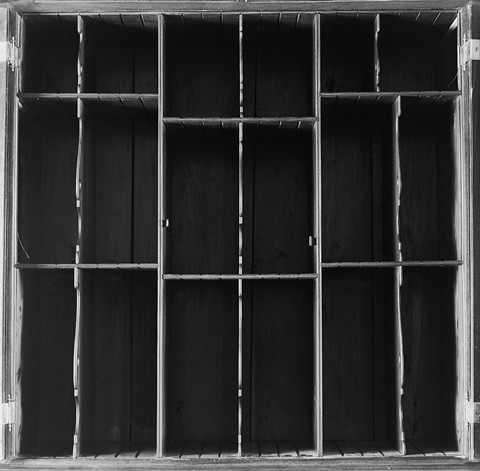
Detail of the bookcase interior of the desk-and-bookcase illustrated in fig. 1. (Bequest of Martha B. Lisle; Photo, Gavin Ashworth.) www.risd.edu

Detail of the desk interior of the desk-and-bookcase illustrated in fig. 1. (Bequest of Martha B. Lisle; photo, Gavin Ashworth.) www.risd.edu

Infrared photograph of the inscription on the back of a drawer in the writing compartment of the desk-and-bookcase illustrated in fig. 1. (Courtesy of Historic New England.)

Infrared photograph of the inscription on the side of a drawer in the writing compartment of the desk-and-bookcase illustrated in fig. 1. (Courtesy of Historic New England.)
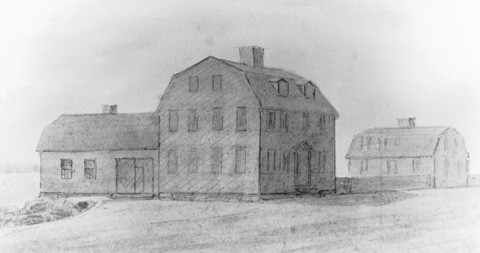
Jonas Bergner, John Goddard’s house and shop, Newport, Rhode Island, before 1870. Watercolor on paper. (Courtesy, Newport Historical Society.)
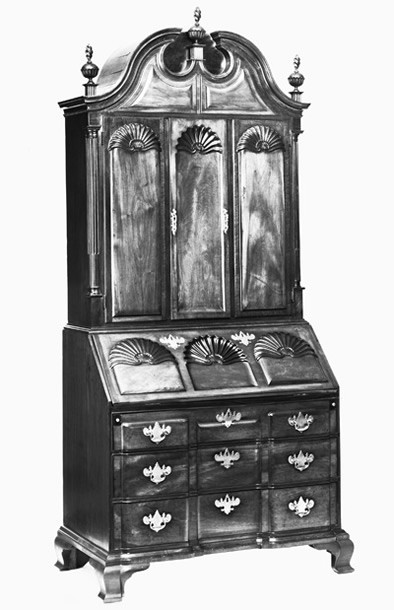
Desk-and-bookcase, Newport, Rhode Island, 1760–1770. Mahogany with maple, red cedar, white pine, and yellow poplar. H. 97 7/8", W. 45 3/8", D. 25 1/2". (Courtesy, Winterthur Museum.)

Detail of the interior of the desk-and-bookcase illustrated in fig. 7.
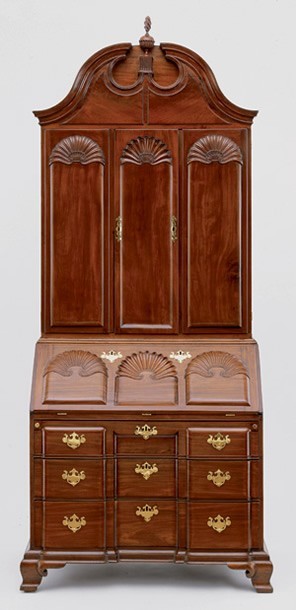
Desk-and-bookcase, Newport, Rhode Island, 1755–1770. Mahogany with chestnut, yellow poplar, red cedar, and white pine. H. 101 3/4", W. 43 1/8", D. 26". (Courtesy, Museum of Fine Arts, Boston.)
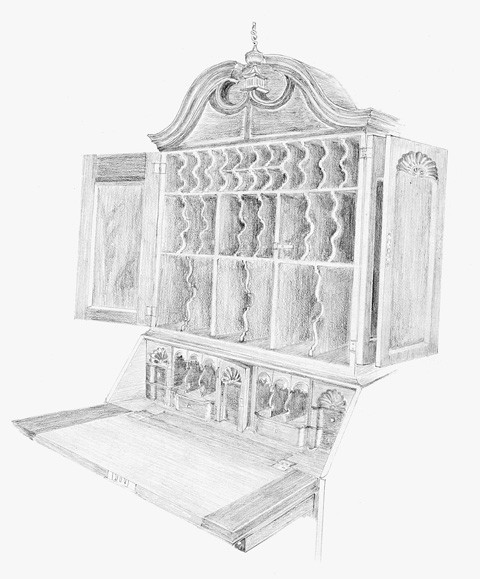
Drawing showing detail of the interior of the desk-and-bookcase illustrated in fig. 9. (Artwork, Wynne Patterson.)
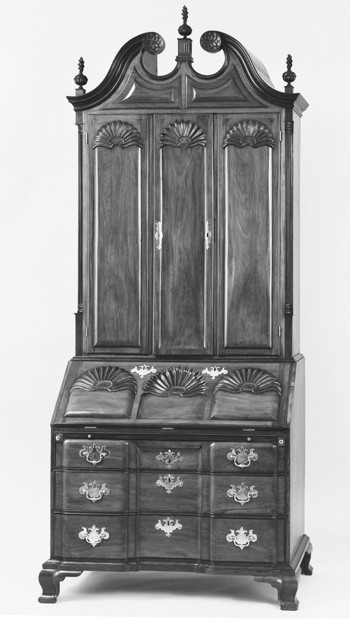
Desk-and-bookcase, Newport, Rhode Island, 1765–1785. Mahogany with cherry, chestnut, white pine, and yellow poplar. H. 106 3/4", W. 44 3/4", D. 24 7/8". (Courtesy, Yale University Art Gallery, Mabel Brady Garvan Collection.)

Detail of the interior of the desk-and-bookcase illustrated in fig. 11.

Desk-and-bookcase, Newport, Rhode Island, 1765–1785. Mahogany with cherry, chestnut, and white pine. H. 113", W. 42 1/2", D. 25". (Courtesy, Christie’s.)
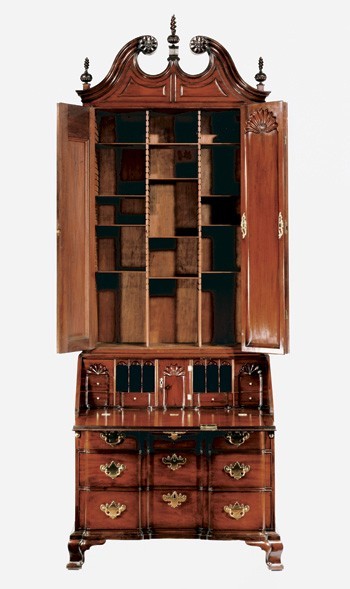
Detail of the interior of the desk-and-bookcase illustrated in fig. 13. (Courtesy, Israel Sack, Inc.)
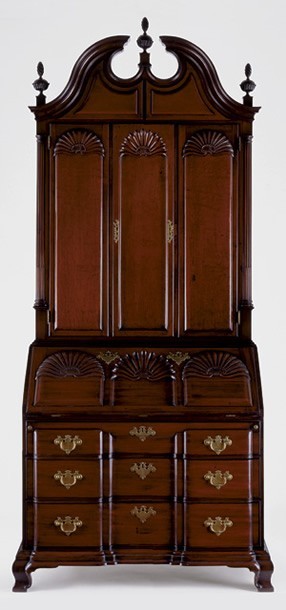
Desk-and-bookcase, Newport, Rhode Island, 1760–1770. Mahogany with maple, red cedar, white pine, and yellow poplar. H. 101", W. 45 1/2", D. 27". (Courtesy, Museum of Art, Rhode Island School of Design, bequest of Martha B. Lisle; photo, Gavin Ashworth.) www.risd.edu
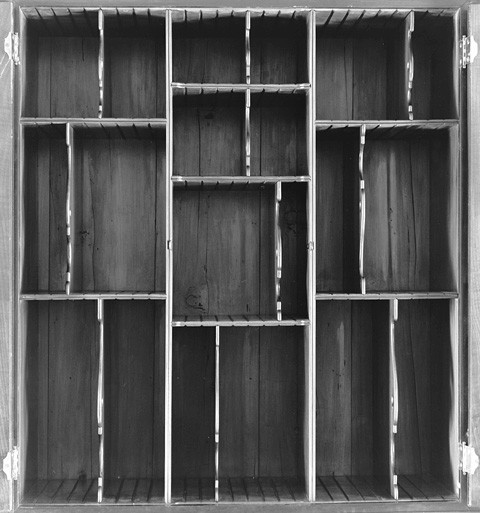
Detail of the bookcase interior of the desk-and-bookcase illustrated in fig. 15. ( Bequest of Martha B. Lisle; photo, Gavin Ashworth.) www.risd.edu

Detail of the desk interior of the desk-and-bookcase illustrated in fig. 15. (Bequest of Martha B. Lisle; photo, Gavin Ashworth.) www.risd.edu
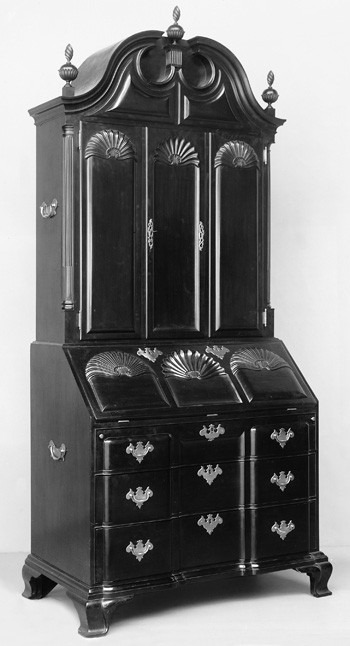
Desk-and-bookcase, Newport, Rhode Island, 1760–1770. Mahogany with cherry, chestnut, red cedar, white pine, yellow pine, and yellow poplar. H. 99 1/8", W. 44 5/8", D. 25 1/2". (Courtesy, Metropolitan Museum of Art, Rogers Fund, 1915.)
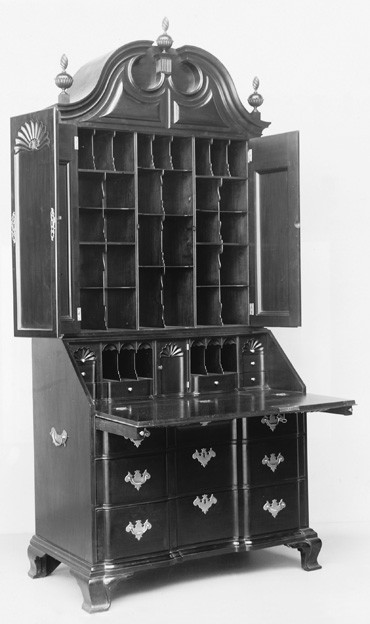
Detail of the interior of the desk-and-bookcase illustrated in fig. 18.
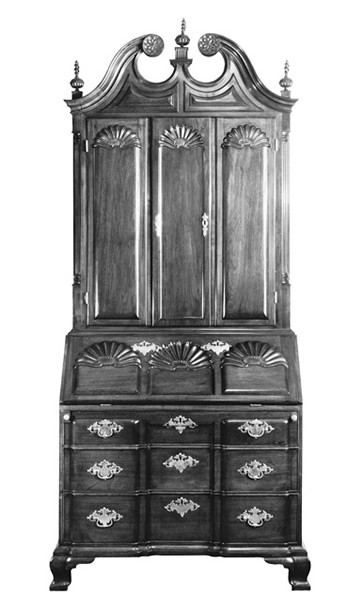
Desk-and-bookcase, Newport, Rhode Island, 1765–1785. Mahogany with cherry, chestnut, maple, white pine, and yellow poplar. H. 99", W. 39 7/8", D. 23 5/8". (Courtesy, Museum of Fine Arts, Boston, M. and M. Karolik Collection.)
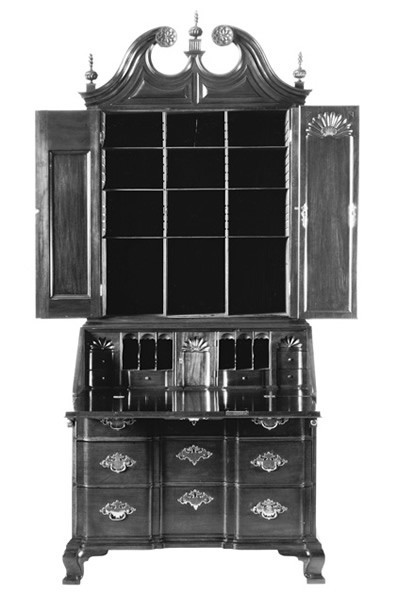
Detail of the interior of the desk-and-bookcase illustrated in fig. 20.
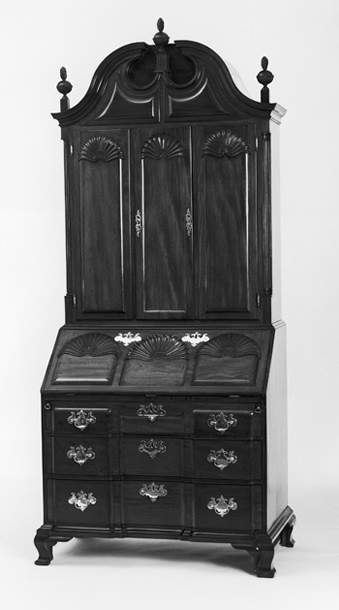
Desk-and-bookcase, Newport, Rhode Island, 1755–1770. Mahogany with cedrela, chestnut, maple, poplar, red cedar, white pine, and yellow poplar. H. 99 3/4", W. 44 1/2", D. 25 1/2". (Courtesy, Museum of Fine Arts, Houston; Bayou Bend Collection, gift of Miss Ima Hogg.)
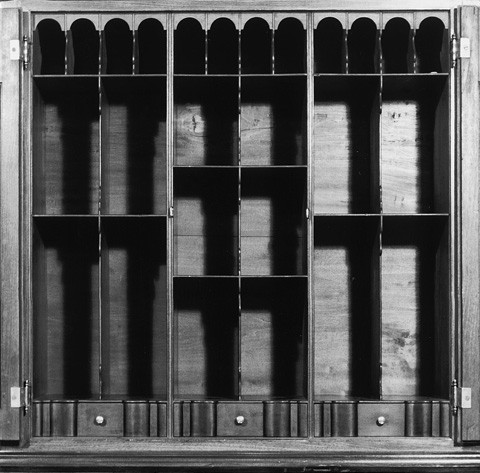
Detail of the bookcase interior of the desk-and-bookcase illustrated in fig. 22.

Detail of the desk interior of the desk-and-bookcase illustrated in fig. 22.
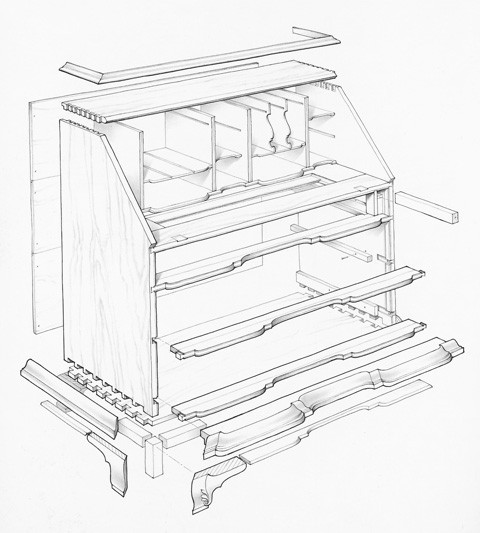
Drawing showing the construction of the lower case of the desk-and-bookcase illustrated in fig. 1. Adapted from Jeffrey P. Greene, American Furniture of the 18th Century. (Courtesy, Taunton Press).
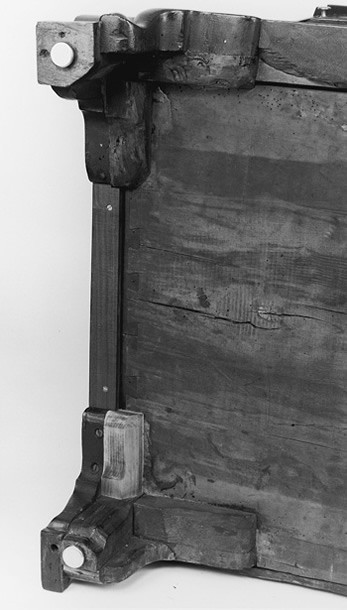
Detail of the foot construction of the desk-and-bookcase illustrated in fig. 1. (Bequest of Martha B. Lisle; photo, Gavin Ashworth.) www.risd.edu

Detail of the lower case interior of the desk-and-bookcase illustrated in fig. 1. (Bequest of Martha B. Lisle; photo, Gavin Ashworth.) www.risd.edu

Detail of the dovetail joints for a valance drawer and a larger drawer in the desk interior of the desk-and-bookcase illustrated in fig. 1. (Bequest of Martha B. Lisle.) www.risd.edu

Detail of the rear surface of a valance drawer in the desk interior of the desk-and-bookcase illustrated in fig. 1. (Bequest of Martha B. Lisle.) www.risd.edu
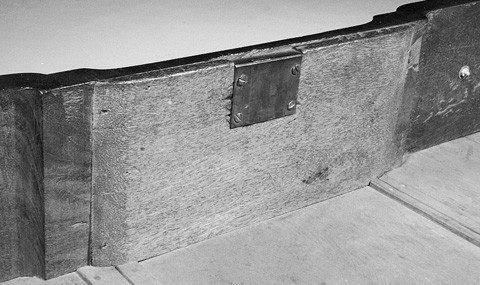
Detail of an applied block on the rear surface of an exterior drawer front of the desk-and-bookcase illustrated in fig. 1. (Bequest of Martha B. Lisle.) www.risd.edu
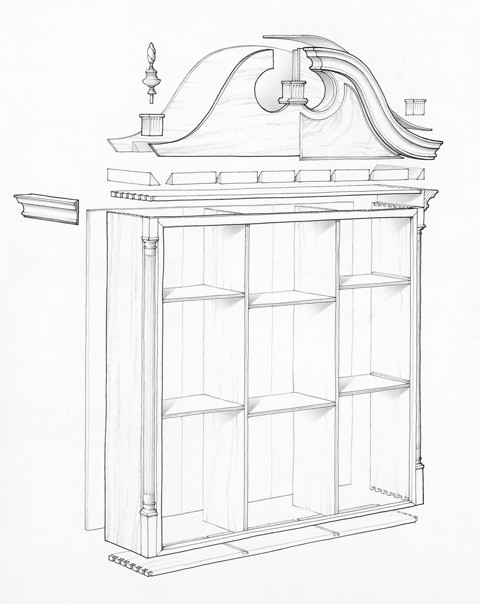
Drawing showing the construction of the upper case of the desk-and-bookcase illustrated in fig. 1. Adapted from Jeffrey P. Greene, American Furniture of the 18th Century. (Courtesy, Taunton Press.)
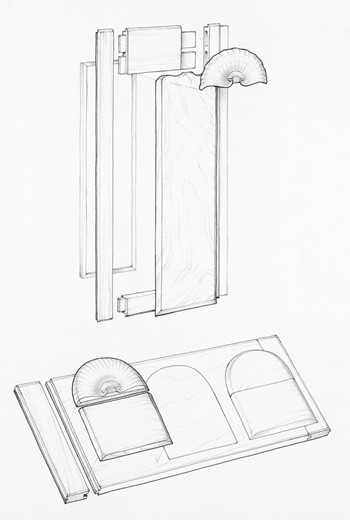
Drawing showing the construction of the desk fallboard and bookcase door of the desk-and-bookcase illustrated in fig. 1. Adapted from Jeffrey P. Greene, American Furniture of the 18th Century. (Courtesy, Taunton Press.)
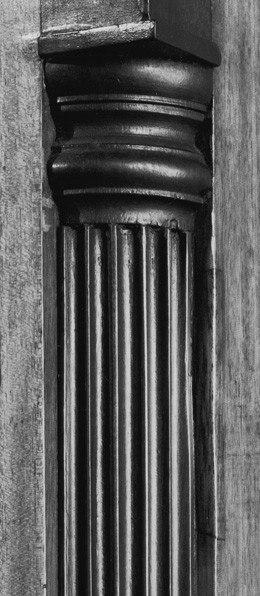
Detail of a quarter-column on the desk-and-bookcase illustrated in fig. 11.
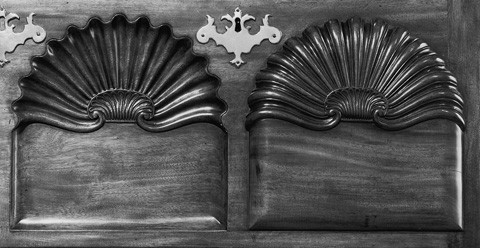
Detail of the carved shells on the fallboard of the desk-and-bookcase illustrated in fig. 11.

Detail of the interior of the lower case of the desk-and-bookcase illustrated in fig. 11.
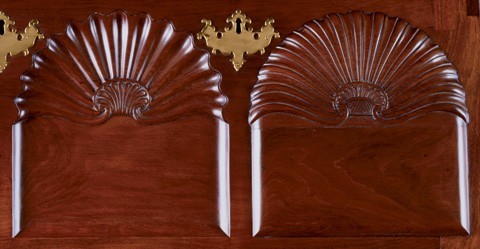
Detail of the carved shells on the fallboard of the desk-and-bookcase illustrated in fig. 1. (Bequest of Martha B. Lisle; photo, Gavin Ashworth.) www.risd.edu

Detail of the pediment, doors, and a finial on the desk-and-bookcase illustrated in fig. 1. (Bequest of Martha B. Lisle.) www.risd.edu

Detail of a quarter-column on the desk-and-bookcase illustrated in fig. 1. (Bequest of Martha B. Lisle; photo, Gavin Ashworth.) www.risd.edu

Detail of a removable side panel in the bookcase interior of the desk-and-bookcase illustrated in fig. 1. (Bequest of Martha B. Lisle.) www.risd.edu
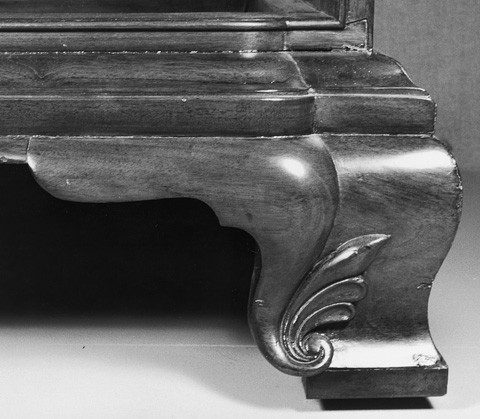
Detail of the front foot of the desk-and-bookcase illustrated in fig. 1. (Bequest of Martha B. Lisle; photo, Gavin Ashworth.) www.risd.edu

Detail of the carved shells on the fallboard of the desk-and-bookcase illustrated in fig. 7.
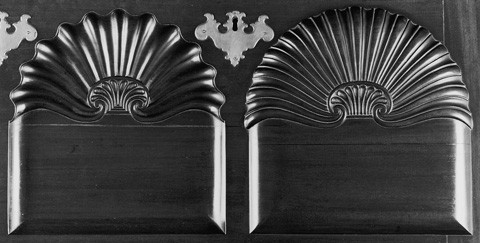
Detail of the carved shells on the fallboard of the desk-and-bookcase illustrated in fig. 15. (Bequest of Martha B. Lisle; photo, Gavin Ashworth.) www.risd.edu
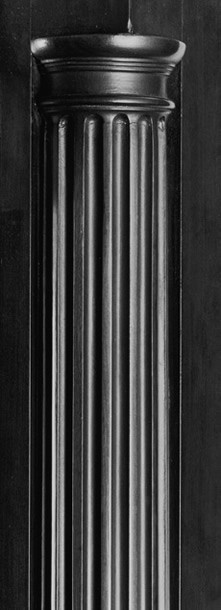
Detail of a quarter-column on the desk-and-bookcase illustrated in fig. 15. (Bequest of Martha B. Lisle; photo, Gavin Ashworth.) www.risd.edu

Detail of the bookcase interior of the desk-and-bookcase illustrated in fig. 1. (Bequest of Martha B. Lisle; photo, Gavin Ashworth.) www.risd.edu
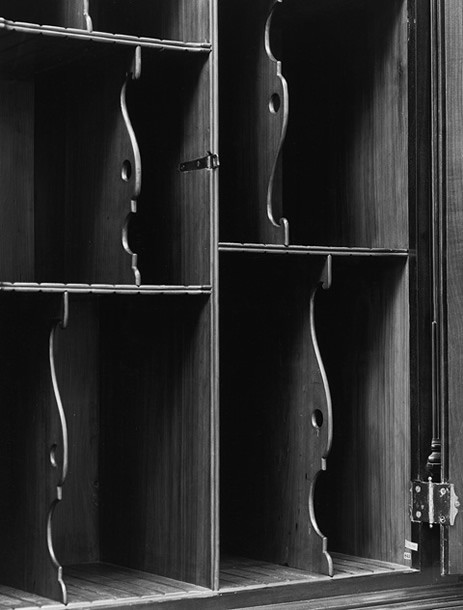
Detail of the bookcase interior of the desk-and-bookcase illustrated in fig. 15. (Bequest of Martha B. Lisle; photo, Gavin Ashworth.) www.risd.edu
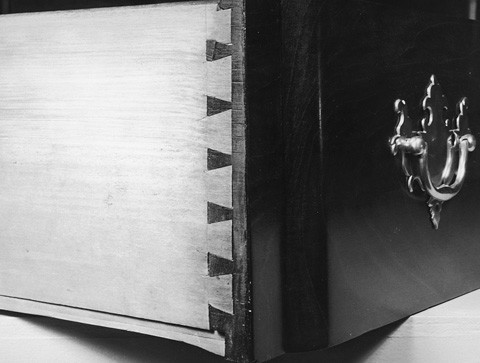
Detail of the dovetailed joint for an exterior drawer of the desk-and-bookcase illustrated in fig. 1. (Bequest of Martha B. Lisle.) www.risd.edu
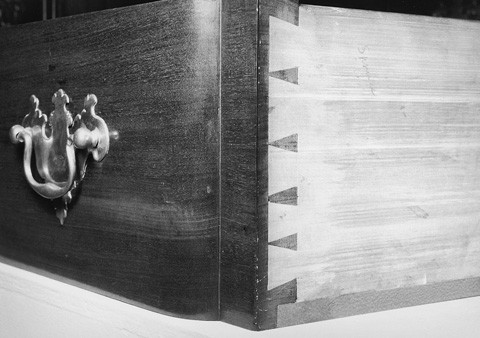
Detail of the dovetailed joint for an exterior drawer of the desk-and-bookcase illustrated in fig. 15. (Bequest of Martha B. Lisle.) www.risd.edu
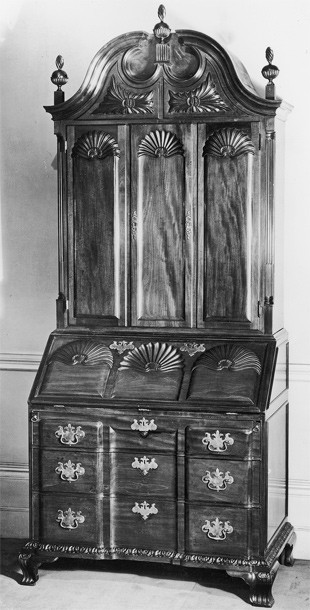
Photograph showing the desk-and-bookcase illustrated in fig. 22 prior to conservation. (Courtesy, Robert W. Symonds Collection, Visual Resources, Winterthur Library.)
No American Furniture form has received more attention than the blockfront desk-and-bookcase with carved shells on the fallboard and bookcase doors (fig. 1). As early as 1913, Luke Vincent Lockwood proclaimed that such examples “are probably as fine pieces of cabinet work as are found in the country.” In Colonial Furniture in America, Lockwood offered the first substantive information on these distinctive objects, linking them to Rhode Island and suggesting a maker—Newport cabinetmaker John Goddard (1724–1785). Subsequent scholars have debated the accuracy of Lockwood’s attributions to Goddard but remained steadfast in their admiration of the form. Collectors have long shared these sentiments. A six-shell, blockfront desk-and-bookcase commissioned by Nicholas Brown (fig. 13) holds the record for American furniture at auction.[1]
Today eleven examples of the form are known. Although all were once attributed to Newport, furniture scholars Wendy Cooper and Tara Gleason have convincingly tied two pieces to Providence. The remaining nine are the focus of this article. Because of its notable history and documentation, the desk-and-bookcase illustrated in figure 1 is a cornerstone for understanding the entire group. It descended in the Potter family of Kingston, and belonged throughout the late nineteenth century to the prominent Rhode Island antiquarian Thomas Mawney Potter (1814–1890). Potter’s nephew later sold the piece to Arthur Lisle, who in 1927 loaned it to an exhibition at the Rhode Island School of Design.[2]
The show’s curator, architect Norman Isham, delighted in the discovery of an inscription scratched into a small drawer behind the prospect door of the desk interior. According to Isham, the inscription stated: “Made by John Goddard 1761 and repaired by Thomas Goddard in 1813.” In his mind, there was no reason to doubt the statement. “It was probably written,” noted Isham, “by Mr. Potter at the time of the repairs by Thomas Goddard. If so, it may be taken as the truth.” Two years later, in 1929, the editor of Antiques agreed that the inscription was authentic but credited authorship to Thomas Goddard rather than the owner. Careful examination of the interior drawers substantiates this claim. Three inscriptions, not one, appear—all in the same hand. On the backs of both the top and middle drawers are the words noted by Isham (fig. 4). But on the right side of the middle drawer is a far longer inscription: “Made by John Goddard 1761 and repaired / by Thomas Goddard his Son 1813 / Hea[l]th Officer of the Town of / Newport Appointed by the / Honr Town Council Members / Nicholas Taylor Esqr & my son T Topham” (fig. 5). The name T. Topham refers to Thomas Goddard’s son-in-law Theophilus Topham who married Susan Goddard. Thomas Goddard’s handwriting on documents dating from the 1820s resembles that on the desk, further confirming Thomas’ authorship of the inscription. A reputable artisan in his own right, Thomas clearly took pride in his father’s accomplishment and sought to perpetuate its record for posterity.[3]
John Goddard’s forty-year career in cabinetmaking was one of the most successful in Newport. It began in the late 1730s, when his father, Quaker housewright Daniel Goddard, presumably apprenticed John and his brother James to joiner Job Townsend. The two young tradesmen later married Job’s daughters, Hannah and Susannah, thus laying the groundwork for a cabinetmaking dynasty. John Goddard’s earliest known work, a plain slant-front desk, bears the label “Made by John Goddard of Newport on Rhoad Island in New England in the year of our Lord 1745.” The detailed reference to location suggests that Goddard intended the piece for export. Like his master, Goddard constructed standard desks with modest decoration for export to towns along the Atlantic coast. The true measure of his success, however, lay with his local clientele. Goddard’s customers consisted of neighboring Quakers and prominent merchants, seamen, and governmental officials across the colony. The list of known patrons reads like a Who’s Who of colonial Rhode Island: Governors Stephen Hopkins and Gideon Wanton, ship captain Anthony Low, and merchants John Banister, Aaron Lopez, Thomas Robinson, Jabez Bowen, and the Brown brothers—Nicholas, Joseph, John, and Moses—of Providence. Goddard’s correspondence with the Brown family documents his production of such fashionable goods as a “Chest on Chest of Drawers & Sweld. front which are Costly as well as ornimental.” Two desks probably made by Goddard in the early 1750s attest to his maturing skills, while an array of documented tables—side, tea, dining, and tilt-top—offer further proof of his keen sense of design.[4]
Such proficiency brought with it a degree of affluence. Tax records suggest that Goddard was Newport’s wealthiest cabinetmaker throughout the 1750s and 1760s and second only to his cousin John Townsend in the 1770s. Like other craftsmen, he sometimes engaged in commercial ventures and became part owner of several vessels; however, cabinetmaking provided the bulk of his income throughout his long career. Ultimately his fortunes did decline, as did those of his neighbors, when British troops occupied Newport during the Revolution. At his death in 1785, he left an insolvent estate. Yet signs of his prosperity were still evident. His home on the waterfront along Easton’s Point, adjacent to the present Robinson House, was a commodious structure, and behind it stood both a shop and small wharf (fig. 6)—the latter an ideal location to unload cargos of lumber or package furniture for export. The shop was, by New England standards, a large one. It contained five workbenches and a vast array of tools. His own sons manned several of these benches at various times. At least four of his and Hannah’s sixteen children learned the trade of cabinetmaking. In his will, he left the shop and its contents to his sons Stephen and Thomas with the stipulation that they should complete the unfinished work for the benefit of their mother. John’s workforce also included at least one slave (his cousin, John Townsend, had three slaves working with him in 1774), but he did not maintain an extensive network of journeymen like some Newport cabinetmakers such as John Cahoone. Goddard and his Quaker kinsmen seem to have tightly controlled their craft environment, thus ensuring consistency in quality and design.[5]
Thomas Goddard (1765–1858) took over his father’s shop and for many years worked in partnership with his brother Stephen. A respected tradesman and staunch Federalist, Thomas served in a number of town offices including health officer of the port, the role noted in his inscription. “He was an erect, fine-looking man, over six feet tall, and a man of great dignity,” noted a great-grandson. Thomas outlived all of his siblings and, as the last of a generation, came into possession of many family items. Only one of these heirlooms can be identified today, but its presence alone offers intriguing insights. According to a late nineteenth-century reminiscence of the colonial Newport furniture trade, “John Goddard...adhered closely to the styles of Sir William Chambers, the brothers Adam, and Chippendale....Goddard’s copy of Chippendale’s quarto volume of designs is now owned by a cabinet-maker in Newport.” Although exaggerating Goddard’s reliance on English design, the account is accurate in its reference to Thomas Chippendale’s The Gentleman and Cabinet-Maker’s Director. This particular volume (Museum of Fine Arts, Boston) bears Thomas Goddard’s signature and presumably passed from John to his son. The elder Goddard apparently knew of English rococo styles but chose to ignore them. Instead, he and his counterparts throughout Newport developed distinctive versions of colonial design that mixed English, French, Boston, and local motifs in innovative ways.[6]
The most expensive objects produced by Newport cabinetmakers were desk-and-bookcases. The form served many purposes: a combination library, office, safe, and closet providing space for books, business accounts, and writing supplies, a surface for reading or writing, small lockable drawers for currency, jewelry, and other valuables, and larger drawers within the lower case for clothing or bedding. Desk-and-bookcases like the Lisle example (fig. 1) also reflected the wealth and status of their owners and marked them as educated and genteel men and women. Although many Newport cabinetmakers made the form, they did so infrequently. Between 1762 and 1778, Job Townsend, Jr. produced no more than six desk-and-bookcases, Benjamin Baker recorded the sale of a single example in surviving accounts during the 1760s and 1770s, and John Cahoone listed only two in the ledger he kept from 1749 to 1760. The cost of these forms exceeded the reach of all but the richest customers. Cahoone charged £200, Baker £300, and Townsend from £200 to £330. By comparison, a mahogany desk averaged about £85 and walnut or maple versions far less. Newport probate inventories for the years 1779 to 1790 list only twelve desk-and-bookcases. The town’s cabinetmakers clearly made additional examples for export, but local patrons probably commissioned no more than sixty desk-and-bookcases during the entire second half of the eighteenth century. Within this small group, blockfront forms with carved shells must have constituted only a small fraction of the total. The nine surviving examples could well represent the majority of those produced during this period. Fire, shipwrecks, and war undoubtedly accounted for some loss; however, the fact that these ornate forms were prized by their original owners and esteemed as family heirlooms encouraged their survival.[7]
At least fifteen Newport craftsmen were capable of producing this level of work during the 1760s. Among the Goddards and Townsends alone are nine candidates: John Goddard and his son Daniel (b. 1747); Job Townsend (1699–1765); Job Townsend, Jr. (1726–1778); the younger Job’s brothers, Edmund (1736–1810) and Thomas (1742–1827); Christopher Townsend (1701–1787); and Christopher’s sons John Townsend (1733–1809) and Jonathan (1745–1773). In addition, another half dozen artisans had shops on Easton’s Point late in the colonial era. A mid-nineteenth-century reminiscence of Newport noted that “the stores of David Huntington and Benjamin Baker were also on the Point; both these men were extensively engaged in manufacturing furniture, which they shipped to New York and the West Indies.” Lesser known cabinetmakers included Benjamin Peabody, Constant Bailey, Walter Nichols, and Timothy Waterhouse. Such a concentration of cabinetmakers handicaps efforts to tie specific pieces to their makers. Collaboration by craftsmen within this group further complicates the issue of authorship. Job Townsend, Jr. engaged his brother Edmund to help make a “Large Mohogony Desk” for Nicholas Anderrese in 1767. Daniel Goddard signed the back of a drawer in a bureau table “Daniel Goddard His Draugh,” suggesting that he designed the piece but may have worked with others to construct it. With numerous shops crowded into a small neighborhood and their owners often linked by kinship, joint productions clearly occurred.[8]
Four of the nine surviving shell-carved desk-and-bookcases have credible histories of ownership but lack documentation to connect original owners to specific makers. The first of the four (figs. 7, 8) belonged to Lodowick Updike II (1725–1804), a wealthy landowner along the western shore of Narragansett Bay in Rhode Island. A second desk-and-bookcase (figs. 9, 10) resided in the same area during the late eighteenth century. An early owner, James Helme, left this example to Elisha Reynolds Potter of South Kingstown, who in 1835 bequeathed it to his son Thomas Mawney Potter, one of Rhode Island’s most noted antiquarians. By about 1870 Thomas Mawney Potter had purchased the Goddard desk-and-bookcase (fig. 1) as well, and for the next twenty years both examples stood in the Red House, Potter’s home in Kingston. The last two examples descended in the Brown family of Providence, Rhode Island. According to family tradition, each of the four Brown brothers—Nicholas (1729–1791), Joseph (1733–1785), John (1736– 1803), and Moses (1738–1836)—owned a version of this grand form. John’s desk-and-bookcase descended in his family until sold in 1918 to collector Francis P. Garvan, who later gave it to Yale University (figs. 11, 12). Nicholas Brown’s piece remained in his family for five generations (figs. 13, 14).[9]
The remaining four desk-and-bookcases have incomplete histories. Noted collector and antique dealer Charles Pendleton acquired one in the 1880s (figs. 15, 16, 17), which he later bequeathed, along with his entire collection, to the Rhode Island School of Design. His friend Richard Canfield, a notorious gambler and bon vivant, purchased another (figs. 18, 19), possibly in Providence, at about the same time. Canfield’s attorney, furniture historian Luke Vincent Lockwood, orchestrated the sale of this piece to the Metropolitan Museum of Art in 1915. A third example (figs. 20, 21) turned up in Providence early in the twentieth century and was acquired by banker and art collector Marsden J. Perry. After his death, the piece was sold to collector Maxim Karolik, who presented it to the Museum of Fine Arts, Boston, in 1939. A final desk-and-bookcase (figs. 22-24) surfaced in London in the 1930s and subsequently returned to America twenty years later. In 1952 Miss Ima Hogg acquired the piece for her home, Bayou Bend, now a part of the Museum of Fine Arts, Houston.[10]
The design of these nine examples is remarkably consistent. At first glance, all appear to have originated in the same cabinet shop (see figs.1–3). A blocked lower case of three drawers rests on a deep base molding and ogee bracket feet with the characteristic Newport cusp. The blocked panels on the drawer fronts continue upward onto the fallboard, terminating in large sculptural shells decorated with fluted centers. The blocking and shells on the bookcase echo that on the desk. Quarter-columns edge the corners of the case on all but one example. At the top, matching panels face the ogee pediment and, on some versions, they are enhanced with blocking. In addition, on five of the nine bookcases, the pediment is fully enclosed by a recessed panel behind the central opening and a full hood. Twisted “flame” finials complete the form. Inside the desk, the interior follows a standard Newport pattern with a shell-carved prospect door flanked by three pigeonholes with valance drawers above and blocked drawers below and to the side. On six of the desk-and-bookcases, a sliding panel in the writing surface allows access to the top drawer—a holdover from wells found on earlier desks. The overall formula is ornamental but integrated. The eye flows easily from the feet to the finials, drawn upward by the dramatic verticals created by the blocking and shells.[11]
Within the case, the construction of each example also appears remarkably uniform (fig. 25). Fine dovetails bind the top and bottom of the desk section to the sides. Base moldings are glued and nailed to the case; the front bracket feet are mitered at the corners and glued to the underside of the base moldings; and a vertical stump flanked by two horizontal blocks reinforces each foot (fig. 26). At the back, the bracket foot is braced by a rear element with a curving diagonal outline. Again, a vertical stump and horizontal blocks support the foot. In addition, an applied strip with a beaded outer edge is sometimes nailed to the base molding between the feet.[12]
Shallow drawer dividers are dovetailed to the sides of the case (fig. 27), and the joints are exposed rather than being covered by a thick strip of veneer as is often the case in Boston or Salem furniture. The dividers and narrow strips of wood nailed to the case sides support the drawers. The lowest divider hangs almost an inch above the case bottom—a practice that also varies from Massachusetts custom, which eliminates this divider and places the lowest drawer directly on the bottom of the case. Thin blocks nailed to the case sides at the back serve as drawer stops. The waist molding is glued and nailed to the top of the desk section; on many Newport high chests and chests-on-chests, the waist molding is attached to the upper case.[13]
The hinged fallboard opens onto two narrow supports that slide out at the upper corners of the case. Occasionally the top edge of the support is gouged to accommodate the shell on the fallboard. The corners of the top drawer are notched to fit around the supports, a standard Newport trait. As a result, the drawer front overlaps the sides, and the two parts are joined in a distinctive manner. Each drawer side is fastened to the front with a vertical sliding dovetail, rather than the typical column of dovetails. The lower two drawers, however, follow the standard method. The well within the interior also conforms to established Newport practice. Exposed dovetails secure the front board of the writing surface. Behind this surface, six-inch-wide boards extend to the back of the case and form a frame for the well. These boards taper at the back and rest on a brace that fits into mortises in the case sides. The cover for the well slides in slots cut in the frame.
The drawers in the desk interior are assembled in typical Newport fashion (see fig. 3). Both the small valance drawers above the pigeonholes and the larger drawers flanking the pigeonholes are joined at the corners with fine dovetails (fig. 28). The drawer bottoms are glued into the rabbeted edges of the sides and back. But at the front, the sides are set into a groove on the valance drawers and glued to a rabbet on the other drawers. The recessed arch on each valance drawer appears to have been made with a jig, possibly a double-edged scratch stock mounted on an arbor. Half of a scribed “X” denoting the center of the drawer front is usually visible on the back (fig. 29).
The large exterior drawer fronts are cut from solid mahogany boards and frequently backed by a thin block of mahogany or cedrela behind the concave section (fig. 30). This allowed the maker to use thinner stock for the front and still provide room for a lock. The dovetailing at the corners of the drawers is precise, but not as fine as some Newport work. The drawer bottoms are typically made of three or four butt-jointed and glued boards with the grain oriented front to back. Each bottom is nailed to the rabbeted edge of the front and flush edge of the sides and back. Runners are fastened along the edges of the bottom. The drawer sides are rounded along the top edge, and the back is cut with a slight chamfer.
The upper case is essentially a dovetailed box with an attached cap (fig. 31). Wedge-shaped glue blocks secure the pediment façade, pediment back, and cornice molding to the top of the case; the hood, usually thin white pine or yellow poplar boards, is nailed to the upper edges of the pediment to strengthen the unit and enclose it. Quarter-columns at the corners on all but one example create pockets within the sides of the case. These pockets, as well as the top and bottom of the bookcase, are covered by slender boards that form a tight liner for the interior. At the back of the case, three or four lap-jointed vertical boards are nailed to the rabbeted edges of the top and sides. The upper case typically sits on support blocks mounted on top of the desk.[14]
The construction of the desk fallboard and bookcase doors (fig. 32) follows a consistent pattern on all nine desk-and-bookcases. Each fallboard is comprised of a single board with cleated ends. The convex blocking and convex shells are glued to the front, and the concave shell is carved in relief. In some cases, the blocking is curved to fit neatly against the lower edge of the shell. On the Lisle desk-and-bookcase (fig. 1) and three other examples, however, the blocking and shell are squared off and butt-jointed. The doors also follow the same pattern. The center door is made of a solid board carved with recessed blocking and a relief-carved shell. Each outer door consists of a joined frame, in which the rails are tenoned through the stiles. The blocked panel is glued to the surface of the frame, and that joint is reinforced by an ogee molding set within the edges of the frame. The shell is glued to the upper rail. Unlike the fallboard where two methods are used to join the blocking and the shell, the decoration on the doors required only one technique. The blocking always slips tightly against the curved lower edge of the shell. If the two were butt-jointed, the vertical-grained panel and horizontal-grained shell would be visually disturbing. By fitting the panel tightly against the carving of the shell, the juncture is less obvious.[15]
With so many similarities in design and construction among the nine block and shell desk-and-bookcases, it is tempting to attribute them to a single maker. Closer scrutiny, however, suggests that they are the products of at least four different shops. Three desk-and-bookcases (figs. 11-14, 20-21) appear to be from the same shop that produced an unusual clothes press, chest-on-chest (both in the collection of the Chipstone Foundation), and bureau table. All six objects share many distinctive traits. The desk-and-bookcases have open bonnets with rosettes decorated with two rows of stylized petals and plain bookcase interiors with adjustable shelves. All of the other examples have fixed shelves and adjustable partitions. The finials on the three desk-and-bookcases also have deeply cut twisted flames, rather than shallow ones. On the bookcase doors, the quarter-columns are framed at the top and bottom with a peculiar sequence of double-beaded turnings (fig. 33). In addition, two of the pieces in this subgroup have roughly carved triangular insets at the upper corners of each door, suggesting that the area may have been gilded or covered with a brass spandrel. The carved shells on the desk and doors are also readily distinguishable from those on the other block and shell pieces; the centers of the shells are broader and more crowded with flutes (fig. 34).[16]
The writing compartments of the three desk-and-bookcases have valance drawers with cherry linings and blocked and shell-carved drawers with white pine frames, backs, and bottoms. The makers of the other pieces used a single wood—usually red cedar or mahogany—for all the interior drawers. All of the valance drawers of the three desk-and-bookcases have one dovetail at each corner, whereas those of the other examples often have two small dovetails. None of the writing compartments of the desk-and-bookcases in this subgroup have wells, but two have writing slides and two have full dustboards in the lower case (fig. 35)—features rarely seen on Newport furniture. The fallboard supports on all three pieces are cherry faced with mahogany, and the partition separating each support from the top drawer extends to the back of the case. The other desk-and-bookcases have mahogany supports and a shallow partition between the supports and drawer. Finally, the exterior drawers on all of the case pieces in the subgroup differ from the norm. Their bottom boards are chestnut with the grain running side-to-side rather than pine or yellow poplar with the grain oriented front-to-back. The chestnut boards are set into grooves in the front and sides and nailed to the back. Although this technique is common in New England furniture of the late eighteenth century, it differs noticeably from the drawer construction of the other desk-and-bookcases.[17]
Within this small cluster of six related pieces, four have histories in Providence. John and Nicholas Brown commissioned the desk-and-bookcases illustrated in figures 11–14, and Providence collector Marsden Perry owned the other example (figs. 20, 21). The bureau table in this subgroup descended in the Bowen family, and the chest-on-chest reputedly belonged to the Brown brothers’ cousin Sarah Brown and her husband Jabez Bowen. Members of the Brown and Bowen families patronized both Newport and Providence craftsmen. In 1763, John Goddard made a tea table and common chairs for Jabez Bowen and a bureau table for Moses Brown. After receiving an order for a case of drawers from Bowen, Goddard wrote Moses Brown “there is a sort which is called a Chest on Chest of Drawers & Sweld. Front which are Costly as well as ornimental. thou’l Plese to let me know friend Bowens minde that I may Conduct accordingly.” Newport furniture of this type probably served as a design source for Providence artisans who made similar forms for the Browns, Bowens, and other prestigious local families.
Although it is tempting to speculate that the chest-on-chest mentioned in Goddard’s letter is the one that reputedly belonged to the Bowens, there is insufficient evidence to support that conclusion. If this piece and the three related desk-and-bookcases could be attributed to Goddard, it would refute the inscription on the Lisle desk-and-bookcase. The construction of the Lisle piece and the furniture in the subgroup that includes the chest-on-chest is too different to ascribe these objects to the same maker.[18]
In many respects, the Lisle desk-and-bookcase (fig. 1) stands alone in the group. It is the only piece that has shells with diapering in the center (fig. 36), and its unique finials have an inverted urn with reeding (fig. 37) rather than a ball-shaped urn with fluting. Although the authenticity of these finials has been questioned, x-radiography indicates that they are original and unaltered. The quarter-columns on the Lisle piece also differ from those on the other desk-and-bookcases in having a one-half-inch gap separating the rounded ends of the fluting from the capital (fig. 38). Typically the end of the fluting extends to the capital (fig. 43). The interior of the bookcase has removable side panels secured with spring latches. These latches, which were discovered during conservation in 1985 (fig. 39), do not occur on any other piece in the group. Similarly, the feet are singular in shape and ornament (fig. 40). A few Newport case pieces with carved feet are known, but none have leaves drawn and modeled like those on the Lisle desk-and-bookcase.[19]
Two desk-and-bookcases (figs. 7, 15) are visually quite similar to the Lisle example, but they appear to have originated in a different shop or are collaborative products involving the maker of the Lisle piece and another cabinetmaker. The shells and quarter-columns present the most noticeable variations. On the desk-and-bookcases illustrated in figures 7 and 15, the fluted centers of the shells nearly match (figs. 41, 42) and the quarter-columns have identical bases and capitals that project beyond the corner post of the case (fig. 43). The quarter-columns on the desk-and-bookcase shown in figure 15 are slightly larger and have seven flutes rather than five.[20]
The bookcase sections of the pieces in this small subgroup (figs. 7, 8, 15, 16) also have similar interiors, although the one shown in figures 7 and 8 has lost its sliding partitions, which probably resembled those on the other example. In their original configuration, both interiors echoed that of the Lisle bookcase (figs. 44, 45). The secondary woods in all three bookcases are also the same: red cedar for the interior linings and case back; yellow poplar for the pediment back and hood; and maple for the top and bottom of the case. Most Newport cabinetmakers would have used chestnut in one or more of these positions.
The panels lining the sides of all three bookcase sections slid into grooves (see fig. 39). On the bookcase illustrated in figures 7 and 8 and the Lisle example, the panels are still removable. The partitions of the Lisle bookcase and the example shown in figure 15 are also removable and have notched numbers on their top edge. On the latter example, the partitions are numbered vertically in columns and then horizontally. Thus, the top left partition has a single notch, the middle left has two notches, and so forth. On the Lisle bookcase, however, the partitions are numbered horizontally along the top row, then the middle row, and finally the bottom. The technique of cutting the notches with a chisel is consistent, but the application varies. Clearly the makers of both pieces were familiar with each other’s work.
The desk sections of the three pieces are also related (figs. 1, 3, 7, 8, 15, 17). In every case, the lower edge of the convex shells on the lid is squared off and butts against the blocking (figs. 41, 42); on all but one of the other six desk-and-bookcases, the blocking is shaped to fit neatly against the scalloped lower edge of the shell (fig. 34). The overall construction of each desk—secondary woods, dovetailing of the case, and fabrication of the dividers, drawer supports, and feet—is similar. Unfortunately the desk-and-bookcase illustrated in figure 7 has replaced drawer linings and feet, but its intact structural features match those of the Lisle (fig. 1) and Pendleton (fig. 15) examples and confirms its relationship to them. The dovetails on the exterior drawers of the Lisle and Pendleton desk-and-bookcases differ only slightly (figs. 46, 47). The pattern and angles of the pins and tails match, but the joints on the Lisle drawers are coarser and have extended saw kerfs. Such comparisons reinforce the theory that the makers of these pieces were associated in some way.
The last three desk-and-bookcases (figs. 9, 10, 18, 19, 22–24) share several features, and the one illustrated in figure 22 is the most ornate in the group. It has pigeonholes with arched valances, ogee-shaped drawer fronts (fig. 23), and carved shells capped with incised arches—details that occur on Newport desk-and-bookcase interiors from the 1750s. The desk-and-bookcase shown in figures 18 and 19 lacks these early features, but is otherwise similar. It and the example illustrated in figure 22 have fixed bookcase partitions with identical profiles (which also resemble the profiles of the partitions in the desk sections) and a single bead on the edge. In contrast, the partitions in the Lisle (fig. 2) and Pendleton (fig. 16) bookcases have double-beaded edges and are removable like those on other pieces in the group. The design of the bookcase interiors illustrated in figures 19 and 23 is also related.[21]
Several features in the desk sections of these two objects (figs. 18, 22) reinforce the connection between them. Most of their secondary woods are the same, and the use of true poplar (also called cottonwood or aspen) for the exterior drawer sides and chestnut for the drawer dividers is distinctive. The applied blocking on the fallboards is scalloped to fit neatly against the lower edge of the convex shells, and the design, modeling, and finishing of the carving is virtually identical. Both sets of applied shells have sixteen large lobes and nine small petals in the center. In addition, the center petal in each shell is convex whereas the others are fluted. The feet of the two desk sections are also similar. The scroll along the inside edge of each front face lacks the pronounced tip seen on feet of the other desk-and-bookcases in the group. These distinctive features are signatures of a particular shop—one that at this point remains unidentified.
Although clearly related to the desk-and-bookcases illustrated in figures 18 and 22, the last example in this study (figs. 9, 10) is the most unusual. It lacks quarter-columns on the bookcase section and has carved shells with open centers in the writing compartment, feet with a reverse-curved scroll beneath the characteristic Newport cusp, and only one finial. Other differences are less obvious. The convex blocking on the drawer fronts and front strip of base molding is applied rather than cut from the solid as on every other desk-and-bookcase in the group. Furthermore, deep gouge cuts outline the shells on the doors and fallboard, a detail far more prominent on this example than on any other from the group. Such idiosyncrasies suggest that the maker had little familiarity with the form at the time he made this desk-and-bookcase and that, when constructing the piece, he had to develop his own solutions for the blocking and shell carving.[22]
Based on its pediment design, the desk-and-bookcase shown in figure 9appears to be an early example by the maker of the Lisle piece (fig. 1). Both objects have tympana with book-matched panels rather than the stepped ones found on other bookcases in the group. Other structural features, however, link the desk-and-bookcase illustrated in figure 9with the examples shown in figures 18 and 22. Two of these pieces (figs. 9, 18) have chalk inscriptions in the same florid script on the backs of their exterior drawers (numerals in one case, letters in another) and shells with stop-fluted centers on their bookcase doors. Although these shared details suggest that all three pieces originated in the same shop, they fail to provide conclusive proof
.
None of the desk-and-bookcases in this survey has survived in pristine condition. The inscriptions on the Lisle piece refer to three separate restoration campaigns including one in 1879 when the desk was “scraped & varnishd.” Another example (fig. 7) has replaced feet, new exterior drawer linings, waist moldings, and finials and lacks its original bookcase partitions. The feet of nearly every desk-and-bookcase in the group have been removed at least once for repair, and the hardware on several of these objects has been replaced. In addition, all of these pieces have been cleaned on several occasions, and most currently have twentieth-century shellac finishes. The most conspicuous alterations occurred on the desk-and-bookcase illustrated in figure 22. When photographed in England during the 1930s, it had carved panels in the pediment, applied moldings on the case sides, leafage on the base molding, and gadrooning on the feet (fig. 48).[23]
During the middle of the eighteenth century, Newport cabinetmakers created what subsequently became an icon of American furniture—the six-shell, blockfront desk-and-bookcase. The similarity of the nine examples documents the presence of a rigid, tightly controlled aesthetic. Unlike Boston or Philadelphia cabinetmakers who offered their clients a wide range of options for specific forms, Newport furnituremakers had a limited vocabulary. Their patrons preferred a few specific designs, and craftsmen continued to provide them for decades.[24]
Within this established format for block and shell desk-and-bookcases, minor variations do occur, which make it possible to subdivide the group. Three of these objects (figs. 11, 13, 20) clearly represent the work of one shop. The design of their shells, layout of their bookcase interiors, and overall construction are remarkably consistent. The two Brown family pieces (figs. 11, 13) may well be the latest in the entire group; the simplicity of their bookcase shelving, lack of a well, and commanding scale suggest a date no earlier than the late 1760s. The Pendleton desk-and-bookcase (fig. 15) and the example shown in figure 7 constitute a second subgroup. The craftsman who made these pieces appears to have been associated with the maker of the Lisle desk-and-bookcase (fig. 1). One maker may have trained the other, and the two may have worked collaboratively on at least one of these three desk-and-bookcases. A third subgroup includes the desk-and-bookcases illustrated in figures 18, 22, and possibly 9, although the last is enigmatic enough to make any conclusion about its origin somewhat problematic. If the example illustrated in figure 9 is by the same maker, it was likely his first attempt at the form. In light of this analysis, these nine desk-and-bookcases represent the output of at least four, and possibly five, Newport shops.
Although the desk-and-bookcases can be separated into groups, the identities of the cabinetmakers that made them remain a mystery. During the 1760s and 1770s, Newport supported more than a dozen cabinetmaking establishments, the most prominent of which was John Townsend’s. Although his furniture ranks at the summit of Newport work, he does not appear to have been involved in the production of any of the surviving desk-and-bookcases. None of the block and shell examples are constructed like the desks documented and attributed to Townsend’s shop, nor do they have the assembly marks that he typically wrote in pencil or chalk.
Job and Christopher Townsend are better candidates for at least some of the six-shell desk-and-bookcases. These brothers were the progenitors of Newport’s most important cabinetmaking shops, and ambitious straight-front desk-and-bookcases by both men survive. Although neither of the documented examples by Job and Christopher share enough features with any of the six-shell blockfronts to warrant an attribution, the relationships between certain subgroups suggest the involvement of at least one multigenerational shop tradition. If the inscription on the Lisle example could be verified, one could postulate that the desk-and-bookcases illustrated in figures 7 and 15 represent the work of John Goddard’s master and father-in-law Job Townsend or another cabinetmaker trained by the latter craftsman. Job trained his sons Job, Jr., Thomas, and Edmund, and may have taken apprentices in addition to Goddard.[25]
Regrettably, John Goddard’s construction of the Lisle desk-and-bookcase cannot be proven at this time. He remains a likely candidate, but three plain desks, supposedly made by him, do not share enough features with the Lisle piece to link the desk-and-bookcase to this noted cabinetmaker. Given the great expense of the Lisle desk-and-bookcase and other pieces in the group, it is surprising that none are signed by the maker or by an early owner. Aside from Thomas Goddard’s remarks and a few notations by later repairmen, the inscriptions on the nine objects are limited mostly to marks designating drawer order or partition locations. These desk-and-bookcases, therefore, remain difficult to document and deserve further study as part of a larger analysis of all Rhode Island case furniture.
ACKNOWLEDGMENTS
I am grateful to the following individuals for their research assistance, critical comments, and access to objects during the preparation of this article: Luke Beckerdite, Allan Breed, Michael Brown, Ralph Carpenter, Linda Eppich, Jeffrey Greene, Morrison Heckscher, Patricia Kane, Alexandra Kirtley, Thomas Michie, Michael Moses, Peter Obbard, Michael Podmaniczky, Ron Potvin, and Gerald Ward.
Luke Vincent Lockwood, Colonial Furniture in America, 2d ed., 2 vols. (New York: Charles Scribner's Sons, 1913), 1:246. The Brown desk-and-bookcase brought $12.1 million (Christie's, The Magnificent Nicholas Brown Desk and Bookcase, New York, June 3, 1989). A Newport desk-and-bookcase signed by Christopher Townsend brought $8,250,500 in 1999 (Sotheby's, Important Americana: Furniture and Folk Art, New York, January 16 - 17, 1999, lot 704).
Wendy A. Cooper and Tara L. Gleason, "A Different Rhode Island Block-and-Shell Story: Providence Provenances and Pitch-Pediments," in American Furniture, edited by Luke Beckerdite (Hanover, N. H.: University Press of New England for the Chipstone Foundation, 1999), pp. 162, 176. The attribution of these two objects to Providence was first suggested in Michael Moses, Master Craftsmen of Newport (Tenafly, N. J.: MMI Americana Press, 1984), p. 303. For the provenance of the Lisle desk-and-bookcase, see Christopher P. Monkhouse and Thomas Michie, American Furniture in Pendleton House (Providence, R.I.: Museum of Art, Rhode Island School of Design, 1986), p. 96.
Norman M. Isham, "John Goddard and his Work," Bulletin of the Rhode Island School of Design 15, no. 2 (April 1927): 23. Homer Eaton Keyes, "The Frontispiece," Antiques 15, no. 4 (April 1929): 277. For further information about Thomas Goddard, see Mabel Munson Swan, "John Goddard's Sons,"Antiques 57, no. 6 (June 1950): 448 - 49.
The best early accounts of John Goddard are Walter A. Dyer, "John Goddard and his Block-Fronts,"Antiques 1, no. 5 (May 1922): 203 - 8; Isham, "John Goddard and his Work," pp. 14 - 24; and Keyes, "The Frontispiece," pp. 275 - 77. For a biography of Goddard, see Michael Moses, Master Craftsmen of Newport, pp. 195 - 200. For information about the history of Goddard's shops, see Ron M. Potvin, "Furniture Makers on the Point, A Selected List of Sites," (unpublished research report, Newport Historical Society, 1999), p. 5. The Goddard desk in the collection of the Chipstone Foundation is illustrated in Oswaldo Rodriguez Roque, American Furniture at Chipstone (Madison: University of Wisconsin Press, 1984), pp. 56 - 59. The application of labels on furniture made for export is discussed in Margaretta M. Lovell, "'Such Furniture as Will Be Most Profitable,' The Business of Cabinetmaking in Eighteenth-Century Newport," Winterthur Portfolio 26, no. 1 (Spring 1991): 44 - 48. It is interesting to note that the Goddard desk at Chipstone has replaced backboards made of yellow pine, suggesting that the object may have been shipped to the South in the eighteenth century and later repaired there. The correspondence between Moses Brown and John Goddard is quoted in Moses, Master Craftsmen of Newport, p. 196, and Goddard's two desks from the 1750s are illustrated on pages 201 - 2 of the same volume.
Inventory of John Goddard, August 1, 1785, Newport, Wills and Inventories, Newport City Hall, I: 267 - 68. Wendell Garrett, "The Goddard and Townsend Joiners of Newport, Random Biographical and Bibliographical Notes," Antiques 121, no. 5 (May 1982): 1154. Lovell, "'Such Furniture as Will Be Most Profitable,'" pp. 50 - 51. Jeanne Vibert Sloane, "John Cahoone and the Newport Furniture Industry," in New England Furniture: Essays in Memory of Benno M. Forman, edited by Brock Jobe (Boston: Society for the Preservation of New England Antiquities, 1987), pp. 93 - 95.
Dyer, "John Goddard and his Block-Fronts," p. 208. George Champlin Mason, Reminiscences of Newport (Newport, R.I.: Charles E. Hammett, Jr., 1884), p. 50. Goddard's copy of Chippendale'sDirector is housed in the Prints, Drawings, and Photographs Department at the Museum of Fine Arts, Boston.
For additional information on uses for desks and desk-and-bookcases, see Gerald W. R. Ward, American Case Furniture in the Mabel Brady Garvan and Other Collections at Yale University (New Haven, Conn.: Yale University Art Gallery, 1988), pp. 343 - 44; and Brock Jobe and Myrna Kaye, New England Furniture: The Colonial Era (Boston: Houghton Mifflin Company, 1984), pp. 226 - 28. In his daybook, Job Townsend, Jr. never specifically bills any client for a desk-and-bookcase. However, it is possible that the "large" mahogany desks or especially expensive desks in his accounts were desk-and-bookcases. His typical charge for a true desk ranges from £50 to £90 during the 1760s and 1770s. The price of his large mahogany desks exceeded £200 and on one occasion amounted to £330. See Martha H. Willoughby, "The Accounts of Job Townsend, Jr." in American Furniture, edited by Luke Beckerdite (Hanover, N. H.: University Press of New England for the Chipstone Foundation, 1999), pp. 133 - 61. On December 26, 1765, Benjamin Baker billed a customer £300 for a mahogany "full [head] desk," which must have been a desk-and-bookcase; his account book lists no other items that could be interpreted as a desk-and-bookcase. See Ron Potvin, "Transcript of Furniture Recorded in the Account Book of Benjamin Baker, 1761 - 1790" (unpublished research report, Newport Historical Society, n.d.). Cahoone's two desk-and-bookcases included a mahogany example costing £200 in 1756. His ledger documents only his credit sales from 1749 to 1760 (Sloane, "John Cahoone and the Newport Furniture Industry," pp. 94, 99). I am grateful to Alexandra Kirtley for her survey of Newport inventories for the years 1779 to 1790. Of the 200 inventories she examined, 125 included a total of 142 desks and twelve desk-and-bookcases. Of the twelve, five are identified as mahogany, one as maple, one as walnut, and five lack any designation. The results of Kirtley's research are on file at the Winterthur Museum.
For lists of Newport craftsmen working in the 1760s, see Garrett, "The Goddard and Townsend Joiners of Newport," pp. 1153 - 55; and Sloane, "John Cahoone and the Newport Furniture Industry," p. 116. Thomas Hornsby, "Newport, Past and Present," Newport Daily Advertiser, December 8, 1849. Job Townsend, Jr. and Edmund Townsend jointly billed Nicholas Anderrese £330 for the "Large Mohogony Desk" on February 28, 1767 (Willoughby, "The Accounts of Job Townsend, Jr.," p. 144). For illustrations and a discussion of the Daniel Goddard bureau table, see Moses, Master Craftsmen of Newport, pp. 265, 271 - 72, 291 - 92.
For more on the desk-and-bookcase illustrated in fig. 7, see Nancy E. Richards and Nancy Goyne Evans, New England Furniture at Winterthur, Queen Anne and Chippendale Periods (Winterthur, Del.: Winterthur Museum, 1997), pp. 439 - 42. Potter family records are ambiguous regarding the histories of the two desk-and-bookcases. An 1836 account book at the Pettaquamscutt Historical Society records the settlement of the estate of Elisha Reynolds Potter. According to the accounts, Potter left a "high desk (formerly James Helme's)" to his son Thomas Mawney Potter. Presumably this is the example (fig. 9) that later passed back into the Helme family, who gave it to the Museum of Fine Arts, Boston (see Richard H. Randall, Jr., American Furniture in the Museum of Fine Arts, Boston [Boston: Museum of Fine Arts, 1965], p. 84). Debra Anne Hashim to Michael Brown, March 26, 1980, object file for 40.790, Art of the Americas Department, Museum of Fine Arts, Boston. In a family note of about 1870, Potter's second desk-and-bookcase is briefly described as: "High book case writing desk in study Dr. P [otter] bought in Newport." William D. Miller, "An Early Rhode Island Collector," Walpole Society Note Book 1935 (Hartford, Conn.: Walpole Society, 1935), p. 45. Christopher Monkhouse and Thomas Michie proposed that this was the one later owned by Arthur Lisle (see Monkhouse and Michie, American Furniture in Pendleton House, pp. 17, 96 - 99). In addition to the two block and shell desk-and-bookcases, Potter also owned a third Newport desk-and-bookcase and a block and shell bureau table, probably the one now in the Museum of Art, Rhode Island School of Design (Monkhouse and Michie, American Furniture in Pendleton House, pp. 84 - 85). Moses Brown's example burned in a fire, and the nine-shell desk-and-bookcase owned by Joseph Brown represents the work of a Providence cabinetmaker. The latter example's design clearly follows a Newport model, but in its details (such as the layout of the desk interior) it stands apart. The Brown family presented the piece to the Rhode Island Historical Society, and since the 1960s it has been displayed in the John Brown House. For information about the Brown family examples, see Ward, American Case Furniture in the Mabel Brady Garvan and Other Collections at Yale University, pp. 339 - 44; Moses, Master Craftsmen of Newport, pp. 328 - 29; Christie's, The Magnificent Nicholas Brown Desk and Bookcase; and John T. Kirk, American Furniture, Understanding Styles, Construction, and Quality (New York: Harry N. Abrams, 2000), pp. 154 - 61. In 1989, to raise funds for the John Nicholas Brown Center for the Study of American Civilization, the family consigned this desk-and-bookcase to Christie's. The desk-and-bookcase remains in private hands.
For the collecting careers of Pendleton, Canfield, and Perry, see Elizabeth Stillinger, The Antiquers (New York: Alfred A. Knopf, 1980), pp. 113 - 21; and Monkhouse and Michie, American Furniture in Pendleton House, pp. 20 - 30. For catalogue descriptions of the desk-and-bookcases owned by Pendleton, Canfield, and Perry, see Monkhouse and Michie, American Furniture in Pendleton House, pp. 97 - 99; Morrison H. Heckscher, American Furniture in the Metropolitan Museum of Art, II, Late Colonial Period: The Queen Anne and Chippendale Styles (New York: Metropolitan Museum of Art and Random House, 1985), pp. 282 - 85; and Edwin J. Hipkiss, Eighteenth-Century American Arts, The M. and M. Karolik Collection (Cambridge, Mass.: Harvard University Press, 1941), pp. 30 - 32. Ima Hogg's desk-and-bookcase is discussed in David B. Warren, Michael K. Brown, Elizabeth Ann Coleman, and Emily Ballew Neff, American Decorative Arts and Paintings in the Bayou Bend Collection (Houston, Tx.: Museum of Fine Arts, Houston in association with Princeton University Press, 1998), pp. 73 - 75.
The Helme desk-and-bookcase (fig. 9) is the only one without quarter-columns. The two pieces with book-matched panels in the pediment are the Lisle and Helme examples (figs. 1, 9). All of the others display raised panels with applied blocks. The five desk-and-bookcases with enclosed pediments are shown in figs. 1, 7, 9, 18, 22. In addition, the five previous pieces and the Pendleton example (fig. 15) have wells in the desk interior.
Typically the beaded strip (fig. 17) on the base molding is present only at the front, not at the sides. Sometimes, as was the case with the Lisle desk-and-bookcase (fig. 26), it was added to the sides at a later date.
For a comparison of standard Boston case construction to that of Newport, see Margaretta Markle Lovell, "Boston Blockfront Furniture" in Boston Furniture of the Eighteenth Century (Boston, Mass.: Colonial Society of Massachusetts, 1974), pp. 81 - 89, especially figs. 58, 59. For information on the application of the waist molding to the upper case in Newport furniture, see Jobe and Kaye, New England Furniture: The Colonial Era, pp. 174 - 75. Of the block and shell desk-and-bookcases, only the one illustrated in fig. 7 has a waist molding attached to the upper case. In this instance the molding is a replacement and has been incorrectly installed.
During conservation of the desk-and-bookcase shown in fig. 7, the board at the center of the hood was removed revealing the original wedge-shaped blocks securing the pediment to the top of the bookcase. At the same time, conservators were able to slide out the panels along the sides of the interior of the bookcase. Behind the panels, they discovered "secret" pockets, one of which contained a packet of eighteenth-century needles.
The squared-off, butt-joined blocking and shells appear on the fallboards of the Lisle desk-and-bookcase (fig. 38) and examples shown in figs. 9, 41, and 42.
For illustrations of the bureau table, clothes press, and chest-on-chest, see Moses, Master Craftsmen of Newport, p. 332; and Roque, American Furniture at Chipstone, pp. 2 - 3, 29 - 31. Also see Cooper and Gleason, "A Different Rhode Island Block-and-Shell Story: Providence Provenances and Pitch-Pediments," pp. 173 - 74.
The linings of the valance drawers within the Lisle desk-and-bookcase (fig. 1) and examples illustrated in figs. 7, 9, 22 are constructed entirely of red cedar. The maker of the desk-and-bookcase shown in fig. 18 used mahogany for the sides and back of the valance drawers but continued the standard practice of using red cedar for the drawer bottoms.
The ties between Providence patrons and Newport craftsmen are presented in Cooper and Gleason, "A Different Rhode Island Block-and-Shell Story: Providence Provenances and Pitch-Pediments," pp. 168 - 184, 195 - 97. The Goddard-Brown correspondence is quoted and discussed in Moses, Master Craftsmen of Newport, pp. 196 - 97.
The x-radiograph of the finial is pictured in Monkhouse and Michie, American Furniture in Pendleton House, p. 98. Although the finial is intact and old, it remains problematic for this desk-and-bookcase. Double-reeded urns are not associated with furniture from the early 1760s, but rather with the following two decades. It is possible that these finials are one of the "repairs" made by Thomas Goddard in 1813. A bureau table signed by John Goddard's son Daniel has feet with leaf carving, but the work is clearly not by the same hand that carved the feet of the Lisle desk-and-bookcase. Moses, Master Craftsmen of Newport, pp. 141, 265, 291 - 93.
The bold, seven-fluted quarter-columns on the Pendleton desk-and-bookcase (fig. 15) resemble columns of similar scale on a bureau table signed by Daniel Goddard. Furthermore, the design of the shells on the two pieces is similar. This prompted Michael Moses to attribute both objects to "Daniel Goddard's family" in Master Craftsmen of Newport, pp. 271 - 72. Although this connection may well be correct, the ambiguity of the Daniel Goddard inscription prevents this author from attributing the Pendleton desk-and-bookcase (fig. 15) and the example shown in fig. 7 to Daniel Goddard at this time.
A desk labeled by John Goddard and dated 1745 (Roque, American Furniture at Chipstone, pp. 56 - 59) and a desk-and-bookcase signed by Christopher Townsend (Sotheby's, Important Americana: Furniture and Folk Art, January 16 - 17, 1999, lot 704) have arches above the pigeonholes. The shaped drawer fronts within the bookcase of fig. 22 are reminiscent of those in the same location on the aforementioned Christopher Townsend desk-and-bookcase. The incised arches surrounding the carved shells on the corner drawers of the desk-and-bookcase shown in fig. 22 are related to those framing shells on early Newport dressing tables. For images of Newport dressing tables, see Roque, American Furniture at Chipstone, pp. 38 - 39; and Moses, Master Craftsmen of Newport, p. 41. Although Newport craftsmen continued to employ each of these features—arches above the pigeonholes, shaped drawer fronts in the desk interior, and incised arches around the carved shells—well into the 1760s, the combination of them here suggests a date in the 1750s for this particular desk-and-bookcase.
Feet similar to those on the desk-and-bookcase illustrated in fig. 9 are on a blockfront chest of drawers at the Museum of Fine Arts, Boston (Moses, Master Craftsmen of Newport, p. 311), and a privately owned desk shown in the seminal exhibition of Newport furniture organized by Ralph Carpenter in 1953 (see Ralph E. Carpenter, Jr., The Arts and Crafts of Newport, Rhode Island, 1640 - 1820 [Newport: Preservation Society of Newport County, 1954], p. 75).
Furniture historian Charles Montgomery examined the desk-and-bookcase shown in fig. 22 in the shop of Stair and Company in London in July 1952. He subsequently sent photos of it to his colleague Joseph Downs, who expressed his concerns. "The carving in the pediment and around the base and feet," Downs wrote, "left me quite skeptical, as it seemed quite out of period with the rest of the design, and I would guess it was somewhat later than the original work." Despite Downs' reservations, Montgomery purchased the desk for the Winterthur Museum. The museum's founder Henry Francis du Pont declined to keep the piece and traded it to antiques dealer John Walton the following September. New York cabinetmaker Ernst Peterson restored the desk-and-bookcase for Walton. He scraped away the carving on the pediment, base molding, and feet; removed the moldings on the sides, and refinished the exterior surface. By November 1952, Walton had sold the desk-and-bookcase to Miss Ima Hogg for Bayou Bend. For a complete history of the piece and its restoration, see Alexandra Kirtley, research report, object folder for B.69.22, Bayou Bend, Museum of Fine Arts, Houston. The author is grateful to Ms. Kirtley for sharing her findings.
Gerald W. R. Ward, "'America's Contribution to Craftsmanship': The Exaltation and Interpretation of Newport Furniture," in American Furniture, edited by Luke Beckerdite (Hanover, N. H.: University Press of New England for the Chipstone Foundation, 1999), pp. 225 - 27, 237 - 44.
A desk-and-bookcase with Job Townsend's label is in the Museum of Art, Rhode Island School of Design (see Moses, Master Craftsmen of Newport, pp. 254, 257; Monkhouse and Michie, American Furniture in Pendleton House, pp. 94 - 96). Among Christopher Townsend's signed furniture is a flat-topped high chest and a dramatic desk-and-bookcase with silver hardware. Both were discussed in Luke Beckerdite, "The Early Furniture of Christopher and Job Townsend," in American Furniture, edited by Luke Beckerdite (Hanover, N. H.: University Press of New England for the Chipstone Foundation, 2000), pp. 15 - 22. Two of the three documented desks by John Goddard are illustrated in Moses, Master Craftsmen of Newport, pp. 201 - 2; the third appears in Roque, American Furniture at Chipstone, pp. 56 - 59. These three examples vary considerably in their individual details. Even in such related features as the shape of the feet on the two pictured by Moses, the craftsmen used different templates in sawing them out.
